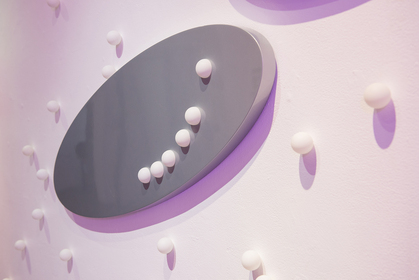-
From Current Issue
-
- Editor’s Letter Fire in the Heart
- Reviews I Gusti Ayu Kadek Murniasih
- Reviews 11th Seoul Mediacity Biennale: “One Escape at a Time”
- Dispatch Networked China
- One on One Monira Al Qadiri on Yukio Mishima
- Essays The rise of independent art spaces in pandemic-era Shanghai
- Features Tuan Andrew Nguyen
- Table of Contents
- Web Exclusives
- Archive
- Subscribe

R
E
V N
E
X
T
The “Considerate Creations: Chameleons” exhibition series, which opened at the Taipei Cultural Center in New York this spring, expanded on the topic of working women artists by highlighting yet another dimension in its second edition: motherhood. While preparing for the presentation at Gallery 456, Taiwanese curator Lee I-Hua shared the news that she was three months pregnant, which added an unexpected, personal significance to the show. The role of a mother is just one of many that female artists inevitably inhabit, according to Lee, who sees the “chameleon artist” as a global phenomenon.
Fellow Taiwanese artist Tsai Hai-Ru illustrates the often-contradictory nature of those various roles in No.Yes.Yes.No. (2016). The Chinese phrases “buyao/yaobu” (“不要/要不”), which can be associated with negotiation or compromise, were affixed to the wall. Red string was attached to each character, and the strands joined together to form a single braid—a burden carried by a Wonder Woman action figure. In an earlier installation of the work, instead of using a pedestal, the artist placed the figurine on the floor. As a result, Wonder Woman often fell over, becoming entangled in the string. Tsai has said that she feels the scenario without the pedestal more accurately resembles her intentions for the piece.
Dueling parts of the self also manifest in Hu Nung-Hsin’s Corpus Callosum (2017), named for the bundle of nerves that joins the two hemispheres of the brain. Hu centers the installation around an actual wall to literalize this division; on each side, she has woven into the wall a live coconut plant as a stand-in for nerve fibers. Above each plant hangs a motion-activated grow light, which can only be triggered from the opposite side of the wall, mimicking how the left-side of our brain controls the right-half of our body, and vice versa. In addition, the two halves correlate to different modes of thinking, such as analytical versus imaginative, and verbal versus visual. Speech itself becomes a tug-of-war for the bilingual artist, who included video recordings of language-learning exercises in order to emphasize the corpus callosum’s function as the conduit between her two selves.
Hong Kong-born Wong Kit Yi goes one step further by divorcing her artistic persona from her professional one, known as Ali Wong. In her second collaboration with composer Kyle Oppenheimer, the conceptual artist expresses her two alter egos through song. The first track “Lunatic” by Wong Kit Yi reads like free association poetry that traces historical and literary associations of the word as ascribed to femininity. The second track “Moonquake,” penned under her professional moniker, opens with lunar facts spoken over Debussy’s “Clair de Lune” (1905), then transitions to upbeat, electronic pop that unpacks the moon as a feminine trope: “soft, gentle, mysterious, passive / (receiving its light from the masculine / sun), orbiting about the earth as a woman / orbits about her man and her family.” Yet Wong’s lyrics purposefully move beyond the domestic space, articulating how the “stereotype of woman has been / molded by history, culture, society.” The installation concludes with an exploration of her “double” identity in a third song called I am Two People by both Wong Kit Yi and Ali Wong.
Chen Hui-Chiao’s The Silver Dust #3 (2010) similarly draws inspiration from celestial bodies by alluding to their orbits in what would otherwise appear to be randomly scattered ping pong balls. The movement of these “planets” and “stars” is meant to parallel civilization’s political and social movements, while nodding to the limitlessness of the universe. The ping pong balls reappear in Between Us (2016), this time balanced upon steel bars, positioned up and down on a figurative scale like notes on sheet music. Chen deliberately coordinated the magenta color of the bars to match that of Wang Te-Yu’s No. 89 (2017), which features a large, balloon-like structure. The interactive nature of the two works reflects not only the artists’ history of collaboration but also Wang’s interest in creating pieces that engage the viewer and invite their participation.
Just as the biographies and resumes of the artists in “Considerate Creations: Chameleons Part II” showcase the various identities they assume on daily basis, the perception as to whether or not these are in competition with one another, or working harmoniously in tandem, varies equally from person to person. It is this pursuit to understand the individual artist’s role in a greater societal context that unifies the seemingly disparate works.
“Considerate Creations: Chameleons Part II” is on view at Gallery 456, New York, until July 14, 2017.
To read more of ArtAsiaPacific’s articles, visit our Digital Library.









